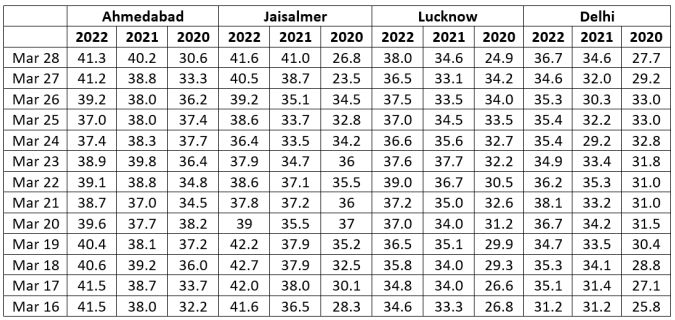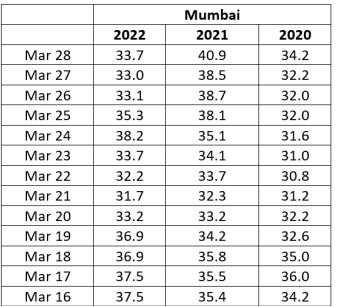
Heat wave engulfing parts of Central and Northwest India during the summer season is nothing new for India. However, mercury soaring beyond 40 degrees Celsius during the middle of March seems to be the new normal.
After a brief respite, mercury is all set to rise once again from March 27-28. Just as the country entered the second week of March, maximum temperatures across central India, especially parts of Rajasthan, Gujarat, Maharashtra and adjoining areas of Madhya Pradesh and Telangana saw temperatures soaring well above 40°C. Mumbai reeled under heatwave conditions for five consecutive days from March 13-17.
In fact, the heatwave has once again returned to the maximum city as maximum temperatures reached 38.2°C on March 23. The normal average for Mumbai for the month of March is 32.8°C.
North-western plains too saw mercury soaring, paving way for heatwave-like conditions. Hot weather conditions were also felt across the hilly states of Jammu and Kashmir, Himachal Pradesh and Uttarakhand, where earlier we used to see snowfall during March as well.
As per the state-run India Meteorological Department (IMD), the heatwave in plains, coastal areas and hilly regions is declared when the maximum temperatures are above 40°C, 37°C and 30°C, respectively and are above the normal average by 4-5 degrees. It is termed a ‘severe heatwave’ if it is above 5-6 degrees.
“Absence of any weather system and presence of an anticyclone over Rajasthan and adjoining Pakistan had been pushing hit winds across North and Central India. March is going to end on a hotter note with no respite till the beginning of April. Light winds and dry weather will once again increase the temperatures over Northwest India leading to heatwave conditions.
Gradually, the heat wave will engulf parts of north Madhya Maharashtra and Vidarbha as well. Pre-monsoon activities will only commence around mid-April across Northwest India, which may give some relief from intense hot weather conditions,” said Mahesh Palawat, AVP-Meteorology and Climate Change, Skymet Weather.
Following are the maximum temperatures recorded during the second half of March in 2020, 2021 and 2022. These temperatures show that there has been a rise witnessed in the last three years.



“While we expect the heatwave to hit parts of central and northwest India by the end of March but so early in the season was not expected. But I would also not be surprised, as we have been witnessing a gradual rise in day temperatures for the last few years. Maximum temperatures breaking records are now here to stay with the rise in global mean temperatures,” said Mahesh Palawat, AVP-Meteorology and Climate Change, Skymet Weather.
Global temperatures have increased and are likely to rise further if unchecked in the coming times. This has been reiterated by scientists across the world time and again. According to the recently released IPCC’s WGII report on Climate Impacts, Vulnerability & Adaptation, globally, heat and humidity will create conditions beyond human tolerance if emissions are not rapidly eliminated. India is among the places that will experience these intolerable conditions.
Wet-bulb temperatures: Currently, wet-bulb temperatures in India rarely exceed 31°C, with most of the country experiencing maximum wet-bulb temperatures of 25-30°C. A wet-bulb temperature of 31°C is extremely dangerous for humans, while a value of 35°C is unsurvivable for more than about 6 hours, even for fit and healthy adults resting in the shade. Even below these levels, heat can be deadly, especially for old or young people or those doing hard physical work.
If emissions are cut, but only by the levels currently promised, many parts of northern and coastal India would reach extremely dangerous wet-bulb temperatures of over 31°C towards the end of the century; if emissions continue to rise, wet-bulb temperatures will approach or exceed the unsurvivable limit of 35°C over much of India, with the majority of the country reaching wet-bulb temperatures of 31°C or more.
The study also mentions that Lucknow and Patna are among the cities predicted to reach wet-bulb temperatures of 35°C if emissions continue to rise, while Bhubaneswar, Chennai, Mumbai, Indore, and Ahmedabad are all identified as at risk of reaching wet-bulb temperatures of 32-34°C with continued emissions; overall, Assam, Meghalaya, Tripura, West Bengal, Bihar, Jharkhand, Odisha, Chhattisgarh, Uttar Pradesh, Haryana and Punjab will be the most severely affected, but if emissions continue to increase, all Indian states will have regions that experience wet-bulb 30°C or more.
Mortality: Heat waves are particularly detrimental to all-cause and cause-specific mortality. Both rural and urban populations are vulnerable to heat-related mortality. Individuals with lower degrees of education and socio-economic status, older individuals and individuals living in communities with less green space are more susceptible to heat-related mortality.
“The heatwave has been reeling parts of India which is rather unprecedented in the month of March. IPCC report placed high confidence that hot extremes climate including heat waves have intensified in the past couple of decades affecting economically and socially marginalised residents.
Global warming is increasingly putting pressure on food production in vulnerable regions as the frequency, intensity and severity of droughts increase from moderate to high between 1.5°C and 2°C global warming levels and under heatwave conditions. It is expected that these extreme events will significantly increase ill health and premature deaths in the near- to long term.
IPCC has placed very high confidence that the population exposure to heat waves will continue to increase with additional warming, resulting in heat-related mortality without additional adaptation,” said Dr Anjal Prakash, Research Director & Adjunct Professor, Bharti Institute of Public Policy, Indian School of Business & Lead Author for the latest IPCC WGII report.
Urbanisation: India is likely to add 416 million urban dwellers between 2018 and 2050. While urban development is necessary for economic growth, it is also contributing to global warming.
“The impacts of heat are not felt equally in a city. People who do not have access to cooling devices or those who have to go outside to work for example construction workers, street vendors. Importantly, the solutions to extreme heat can also give unequal outcomes. For example, tree planting tends to take place in wealthier neighbourhoods. Thus, keeping disproportionate impacts of extreme heat in mind is critical,” said Dr Chandni Singh, Senior Researcher at Indian Institute for Human Settlements & Lead Author for the latest IPCC WGII report.
“With development, the weather of the cities has also completely changed. Concrete and built-up material have been keeping the weather hot by trapping the winds. The Urban Heat Island (UHI) effect is playing a major role in heating up urban areas. Loss of green covers and absence of enough shade to accommodate more people in a city would have a devastating impact on public health,” said Palawat.
India currently loses around 259 billion hours annually due to the impacts of humid heat on labour, up from a previous estimate of 110 billion hours. In terms of changes, in the first 20 years of this century, India lost 25 billion more hours annually compared to the previous 20 years. Also, agricultural labour capacity in India would decrease by 17% if warming continues to 3°C and to 11% if emission cuts are accelerated across the country. Under all these circumstances, we are afraid that intense heat is here to stay.